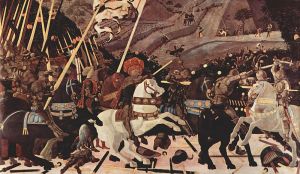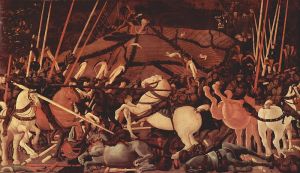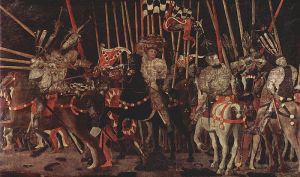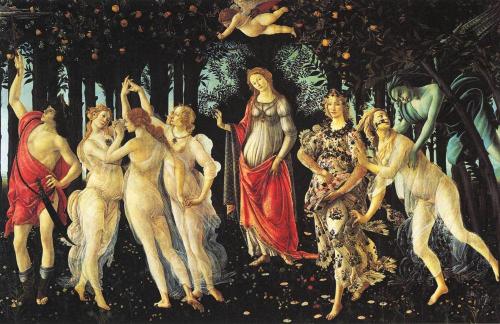


Paolo Uccello, a Florentine painter, was the artist behind this great masterpiece. The Battle of San Romano, comprised of three panels – each 10 feet wide and 6 feet tall, was completed in 1483 and believed to be a commission from a very wealthy banker – Lionardo Bartolinis Salimbeni. All three panels depicted the great 1432 war between the Florentine army and the army of Siena. Interestingly, it took a much longer time before this piece was brought to the attention of the 19th century British art public, who looked to Michelangelo and Leonardo Da Vinci as makers of high art; anything before them, it seemed, were deemed as barbaric.
This piece was interesting because of its massive scale, its secular subject matter and most notably, the use of perspective in drawing which had been the hallmark of all high renaissance works. In particular, if one were to look closely at the first panel, Niccolo Mauruzi da Tolentino at the Battle of San Romano, you can see hints of perspective calculations from the way Uccello had arranged bits of the broken shafts on the ground. The pieces formed a grid-like pattern consistent with the preparatory base he would have worked on – the vanishing point disappearing right into the middle of the painting.
Art historians had also found evidence suggesting that the meticulous and sensitive depictions of the knights in combat were derived from interviews conducted with the knights; the soldiers had had to demonstrate the movements for Uccello in order for him to paint such combat moves with accuracy. It should be pointed out as well that the panels as we are viewing it is far from its original form. Firstly, the top part of the painting is cut off abruptly. There was evidence showing that the commissioned work was meant to be fitted onto the walls of Bartolinis house and very likely rounded like a dome (imagine a semi-circle placed on top of each rectangle). This explained why the work may look strangely claustrophobic as it is; the original version would very likely have shown valleys in the distance and skies in the background.
Secondly, much of the work had been restored over the centuries and may not have retained the original intentions of the artist. For example, Uccello had used egg tempera to construct the masterpiece and the gold and silver colours on the knights were intended to glitter under the candlelight – the way it was meant to be viewed with; certainly the harsh lighting beaming down from gallery ceilings would have created a very different effect for the contemporary art public. Currently, all three panels have been separated, each housed in a museum in a different country – the National Gallery of London, the Uffizi Gallery and the Louvre (Paris).

